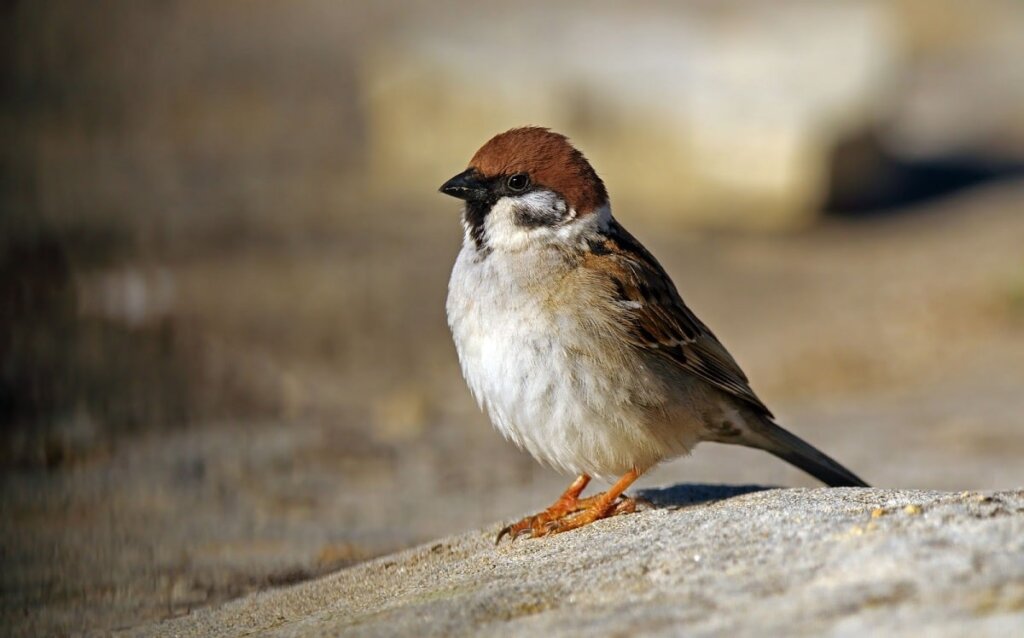All About the Eurasian Tree Sparrow

Sparrows are small, very well-known birds that live in close proximity to humans. There are different species, but they’re very similar to each other. Among the 50 types, we have the Eurasian tree sparrow, so called because of its predilection for grains.
It’s known as the Eurasian tree sparrow because of its native distribution. Its scientific name is Passer montanus and it belongs to the Passeridae family and the Passeriformes order. If you want to find out more about it, read on to discover more about its habitat, characteristics, and conservation status.
Where does the tree Eurasian sparrow live?
As we have mentioned, this bird is widely distributed, and found in Europe and part of Asia (hence its name Eurasian). In addition, it was introduced into North America. Its habitat includes forests, gardens, and cultivated areas in some parts of its distribution. In others, it prefers more urbanized places, particularly if the house sparrow (Passer domesticus) is absent in these areas.
The word montanus in the scientific name of this sparrow means from the mountains, although its habitat is more related to fields and urban areas
Physical characteristics of the Eurasian tree sparrow
This species is similar to the other types of sparrows. It’s small and is no longer than 140 millimeters (5.5 inches) and 20 grams (0.8 oz) in weight. It has brown tones in the upper part of its body, while the ventral region is lighter with a cream color. Although similar in appearance to other members of the group, it’s distinguished by a black spot that stands out on its white cheeks.
They have two thin white bands on the wings. They also have a strong, conical-shaped, gray bill, with light legs and dark brown eyes. Individuals of both sexes are similar and younger birds have lighter shades of plumage.
There are 9 subspecies or types of Eurasian sparrows, based on slight differences in their coloration and geographic location.
Behavior
In some places, the birds are sedentary, while in others they may move around a little. Sparrows are sociable and vocal birds, with different types of sounds. Those they make during breeding are quite loud. They also have alarm vocalizations in case of danger. Likewise, the young emit characteristic calls.
What do tree sparrows eat?
These birds are omnivorous, as they include both animals and plants in their diet. However, they have a preference for vegetables, specifically seeds, and their morphological characteristics allow them to consume them. Among these aspects, we can mention the strong, conical beak and a well-developed crop.
Their diet varies according to season and availability. Generally, in winter the diet is almost entirely covered by small wild seeds found in abundance in the area. The fruits of grasses stand out here. They also include cereals, such as wheat, oats and barley.
During spring, they increase their consumption of animal protein. This is due to the higher nutritional demand for reproduction. Thus, it’s common for them to ingest insects, such as aphids and beetles.
Reproductive behavior
They’re monogamous birds, whose reproduction begins around March, when the male looks for a place to lay eggs. Courtship includes plumage display behavior, with wing and tail spreading, in addition to the emission of characteristic vocalizations. It can also provide material and perform flights to surprise the females.
Although they don’t show aggressive behavior at other times of the year, during breeding, males defend the territory chosen for this purpose. They lay several clutches a year. Both sexes help in the construction of the nest and care of the young.
The nest is ovoid in shape and can be open or closed, with a small opening at the front. It’s made of various materials, dry grass, twigs and roots. In addition, they place feathers, hair, wool and even artificial material on the inside.
These birds use any type of nook, cranny, hollow, or hole to place their nest, from natural to anthropogenic places, but they prefer tree holes. They also accept nest boxes in their territories to lay their eggs.
Laying is variable, ranging from 2 to 7 eggs. Eggs are smooth with different color patterns, shapes, and sizes. Generally, they’re clear with abundant dark brown spots, which sometimes appear uniform, so they don’t stand out from the tone of the background. However, other eggs may have fewer specks. The incubation period lasts about 13 days.
Conservation status of the tree sparrow
P. montanus isn’t endangered, as its distribution is quite wide. The International Union for Conservation of Nature classifies it as of Least Concern, globally and in Europe. However, the population is estimated to be in decline. The main threats include the increased use of pesticides and herbicides.
Overall, the Eurasian tree sparrow is a small, sociable and charming bird, like all members of the group. It prefers to feed on seeds, but adapts its diet according to its nutritional needs and the availability of the environment. A versatile bird that we all enjoy watching in all its splendor.
All cited sources were thoroughly reviewed by our team to ensure their quality, reliability, currency, and validity. The bibliography of this article was considered reliable and of academic or scientific accuracy.
- BirdLife International. (2017). Passer montanus (amended version of 2017 assessment). The IUCN Red List of Threatened Species 2017: e.T22718270A119216586.
- De Castro, C. (2017). Calidad parental del gorrión molinero (Passer montanus) en entornos urbanos. [Tesis de grado, Universidad Complutense de Madrid]. https://www.ucm.es/data/cont/media/www/pag-87789/TFG_Cris_deCastro.pdf
- García-Navas, V. (2016). Gorrión molinero – Passer montanus. En: Enciclopedia virtual de los vertebrados españoles. Salvador, A., Morales, M. B. (Eds.). Museo Nacional de Ciencias Naturales, Madrid. 1-19 páginas. Recuperado de: https://digital.csic.es/bitstream/10261/111688/6/pasmon_v3.pdf
- Sánchez-Aguado, F. (1986). Sobre la alimentacion de los gorriones molinero y común (Passer montanus L. y P. domesticus L.), en invierno y primavera. Ardeola, 33(1-3), 17-33.
